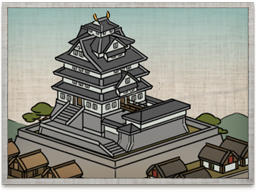Difference between revisions of "Castle (TWS2)"
(Created page with " {{Building TWS2|image=Image:Castle S2TW.png |Chain=Castle Type |Requires='''Buildings''':<li>Fortress</li>'''Resources''':<li>Stone</li> |Enables='''B...") |
m |
||
| Line 1: | Line 1: | ||
| − | {{Building | + | {{TWS2 Building|image=[[Image:Castle S2TW.png]] |
|Chain=Castle Type | |Chain=Castle Type | ||
|Requires='''Buildings''':<li>[[Fortress (TWS2)|Fortress]]</li>'''Resources''':<li>Stone</li> | |Requires='''Buildings''':<li>[[Fortress (TWS2)|Fortress]]</li>'''Resources''':<li>Stone</li> | ||
Revision as of 09:24, 21 December 2011
| Castle (TWS2) | |
|---|---|
 | |
| Chain | Castle Type |
| Requires | Buildings: |
| Enables | Buildings: |
| Spawned Defence Forces | Units: |
| Basic Building Statistics | |
| Clan Effects | |
| See main article; FotS Buildings | |
Description
Absolute mastery, expressed in stone, is also a message.
Building a castle is a sign of absolute ownership, as it provides a strong defence against enemy assaults and a centralized administration for the province. It is a clear sign of the builder’s prestige and wealth. With such a massive structure to defend them, the people will feel secure, but they will also understand that they must keep to their allotted stations in life. Tax income is also improved for the owning clan.
The Sengoku Jidai saw castles develop far beyond mere military strongholds and into being the central hubs for entire towns. The castle was where the daimyo lived, had his government, and encouraged the arts and culture. For the daimyo’s reputation, it was important to impress and intimidate guests in equal measure. The inner layout was designed to force the enemy along complex, exposed routes to the central citadel, so that they could be under fire every step of the way.
The cost of building and maintaining even one castle was almost crippling, so it became a measurable and public example of wealth, power and good taste. A great deal of prestige was gained by a daimyo’s patronage of the arts, and special pieces were commissioned often portraying beautiful landscapes or the clan’s victories, all designed to subtly display the clan’s virtues!